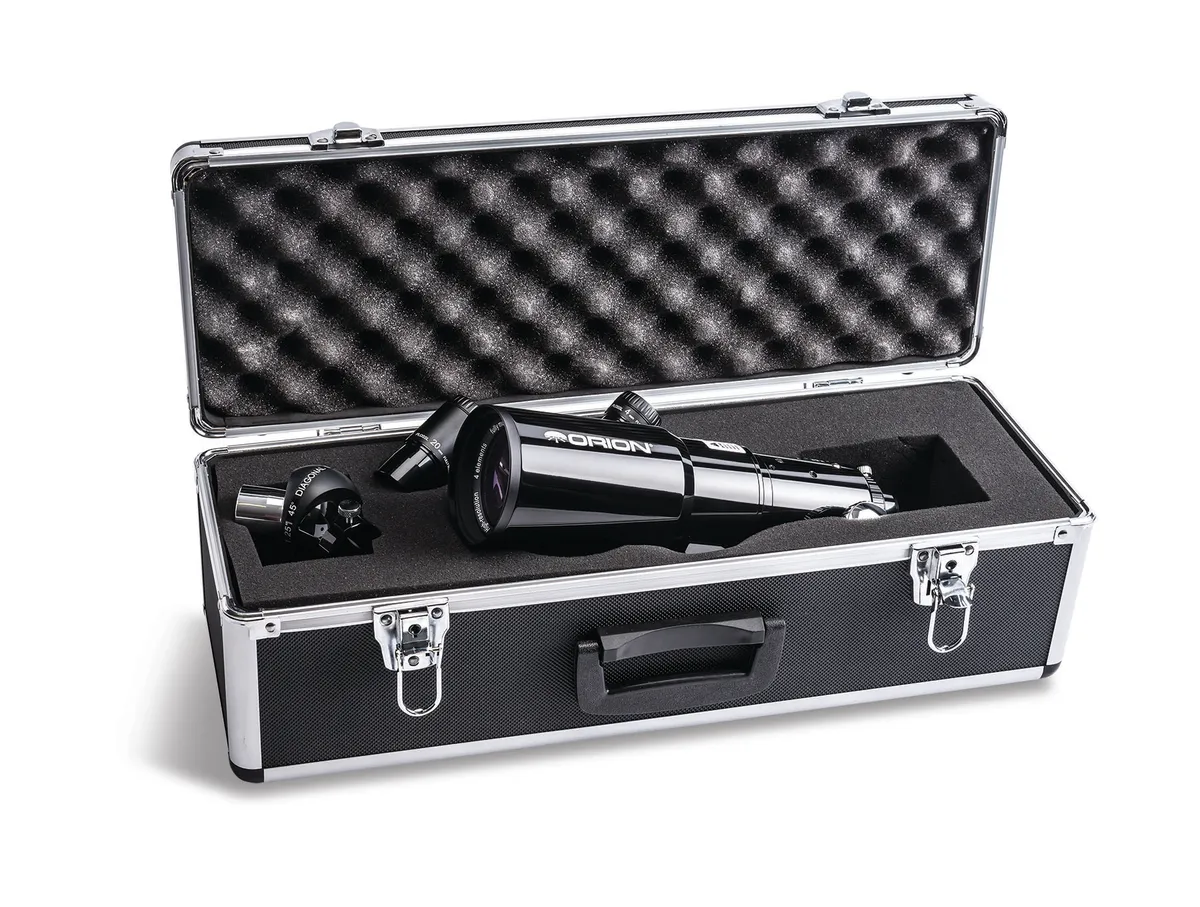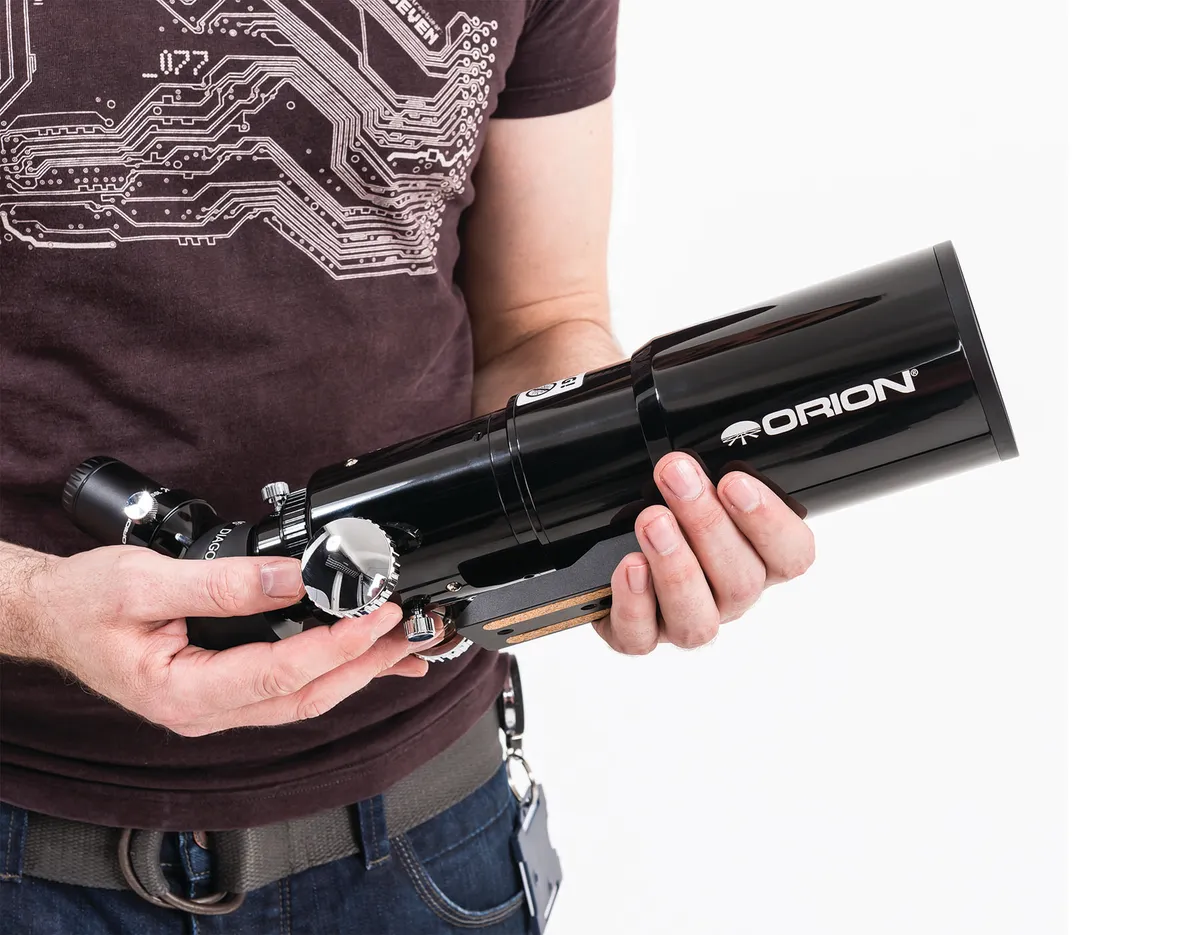The Orion StarBlast compact travel refractor is marketed as a great scope to take on trips away, but should also appeal as a very suitable beginners’ instrument.It possesses a 2.5-inch, four-element crown and flint glass objective, a focal length of 520mm, along with an extendable dew shield.
Also included are a Crayford focuser, 20mm and 4mm eyepieces, a 45° erect-view diagonal, a Vixen-style dovetail mounting block and a hard carry case.
The metal lens cap is flock-lined and fits snugly, while plastic dust caps are provided for the drawtube, diagonal and all eyepieces.
The elements of the telescope itself all appear to be accurately assembled and maintenance on a small refractor like this really only requires occasional dusting and wiping off fingerprints, which seem to show up rather easily on the glossy tube.
The mounting arrangement consists of an alloy dovetail block fitting standard Vixen clamps, which has two ¼-20-inch threaded holes and grippy cork pads for use on photographic or field tripods.
The two mounting holes are useful for balancing the system – especially if you add a camera.
The drawtube extends up to 60mm and is clearly marked so you can reproduce your optimum setup quickly.
The focuser is designed to fit standard 1.25-inch eyepieces and accessories, but also has a 42mm external thread, which means a number of other accessories can be attached.
To facilitate imaging, the package is rounded off with a T-threaded extension tube.This can be screwed onto a T-ring adaptor to suit a DSLR camera, or into a dedicated astronomy camera.

Clear, plainly worded instructions and photographs are provided, although setting up is simple enough that they are reassuring rather than essential.It was good to note, however, Orion’s sound advice and sensibly suggested first targets for a telescope aimed at beginners.
In keeping with its likely use, we tested the StarBlast on both a small equatorial mount and a sturdy photographic tripod.In the latter configuration we really did appreciate the joys of a truly lightweight and simple setup.
During the testing period we experienced the wettest winter on record, so it was great to be able to dash outside, get our gear ready and start observing in a matter of minutes, whenever there was a break in the clouds.
A 2.5-inch refractor like this is ideally suited to bright objects such as the Moon, the planets and nearby star clusters, but under good and dark conditions it’s also possible to see some fainter deep-sky targets; we managed to get some great views of the Orion Nebula and the Andromeda Galaxy.
When the skies were clear we were impressed with the sharp views this little scope produces.The field is very flat and stars were pin points right to the edge of the view.
With the 20mm eyepiece fitted we could see the belts of Jupiter and their subtle colour variations, and of course the four Galilean moons.
The Pleiades was sharp with hints of nebulosity and we could easily discern the wispy arms of the Orion Nebula embracing the brighter core containing the Trapezium stars.
We weren’t able to achieve too much with the 4mm eyepiece as the seeing was not great and high magnifications require a very stable mount plus a finderscope.Owners of this scope will probably get more use from an eyepiece in the 8-12mm range.
On the brightest stars and around Jupiter’s limb, we noticed some chromatic aberration, which was a little distracting and probably due to the non-ED glass elements used in the main optics.
This effect was also seen during daytime use when tree branches were silhouetted against a bright sky, although we were impressed with the bright colour and good contrast when we turned it towards some birds in a nearby garden.
As a travel or beginner system Orion seems to have hit the spot.
This certainly is a compact piece of equipment, and the quality and build of the components used means it is both light and performs well as a wide-field instrument.

Portable powers
For us, the outstanding feature has to be the StarBlast’s travel friendly nature.
The fact that this is advertised as a travel telescope implies it should be small and light and robust, and it is all of those things, but we also loved the speed and ease with which we could set it up for simple observing.
This is a delightful, well-built little instrument, with good quality features and useful accessories.
It is likely to see more use than more elaborate or less intuitive kit, and it is so simple and effective that it would make a great starter telescope for a beginner seeking a more stable platform than binoculars, but without the need for a large mount.
It would also suit dedicated amateurs who require an instrument that can be taken on trips or carried in the back of the car for those moments when you simply have to stop and look up at the sky.
It could even be piggybacked on top of a longer focal length telescope to offer alternative wider views or for imaging purposes.
Smooth focusing
Focusing is achieved by a single-speed Crayford type mechanism; a focus shaft moves the tube back and forth with no obvious backlash (unwanted play in the system).Movements are smooth and positive, and a locking screw is provided, although there is no way to easily adjust the stiffness of this action.
Great build quality
The telescope tube is an all-metal construction, finished in gloss black with silver focus wheels.It exudes quality, with well-chosen materials, excellent finishes internally and externally, and good attention to detail.All internal surfaces have a deep matt black finish to absorb stray light and the tube is very effectively baffled.
Eyepieces
The kit includes two Plössl eyepieces, 4mm and 20mm.Both have good optics and well-made bodies with safety undercuts and filter threads.The 20mm version was particularly suited to the telescope and gave sharp views of celestial targets.We would have liked to have seen eye shields to block stray light though.
Compact design
The diminutive tube is only 30cm long with its dew shield retracted and drawtube wound in, making it about as small as a usable telescope can get.The rigid, foam-lined flight case also has space for the supplied accessories and room for more, with airline cabin-friendly dimensions of just 54x19x17cm.
Erect-view diagona
The prism in this diagonal produces an image that is both the right way up and the right way round.This is perfect for daytime use (such as birdwatching) and is less confusing when learning to navigate around the night sky, making it particularly suited to beginners.
Where to buy
- Orion StarBlast 62mm compact travel refractor at Amazon
- Orion StarBlast 62mm compact travel refractor at Orion Telescopes
Vital stats
- Price£399.00
- Aperture62mm (2.5 inches)
- Focal Length520mm (f/8.4)
- Weight1.4kg
- Supplier The Widescreen Centre
- Telephone020 7935 2580
- Websitewww.widescreen-centre.co.uk
This review originally appeared in the May 2014 issue of BBC Sky at Night Magazine.
